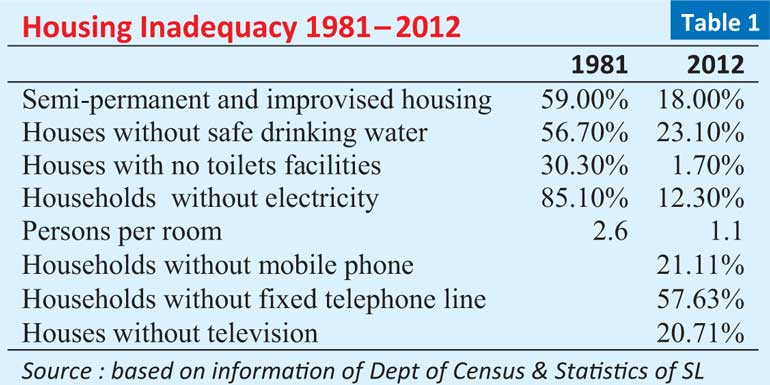Wednesday Apr 24, 2024
Wednesday Apr 24, 2024
Wednesday, 21 September 2016 00:01 - - {{hitsCtrl.values.hits}}
Proper housing is a fundamental need and important component of the right to an adequate standard of living. According to the UN International Covenant on Economic, Social and Cultural Rights, everyone has the right to an adequate standard of living, including adequate food, clothing and housing and continuous improvement of living conditions.
The human right to adequate housing is the right of every man, woman and child to gain and sustain a secure home and community in which to live in peace and dignity (E/CN 4/.2001/51.para.8).
Adequate housing was first recognised as part of the right of the adequate standard of living in the 1948 Universal Declaration of Human Rights and in 1966 it was further reinforced by the UN International Covenant of Economic, Social and Cultural Rights. Since then adequate housing is recognised by the global legal system as the central place to realise the right to an adequate standard of living and its progressive improvement. The right to adequate housing is the central point to the enjoyment of all economic, social and cultural rights and applies to everyone.
What constitutes an adequate house?
The concept of adequate housing gives a broader picture of human settlement. As cited by UN Special Rapporteur on Adequate Housing Raquel Rolink: “A home is not a commodity - four walls and a roof. It is place to live in security, peace and dignity, and a right for every human being.” Which means that, more than four walls and a roof, there are several other conditions that must be met before a particular form of shelter can be considered ‘adequate housing’.
As described in UN Fact Sheet No. 21 (Rev 1), for a house to be adequate it must at a minimum meet the following criteria, which are considered components of the right to adequate housing:
1. Availability of services, materials, facilities and infrastructure: Housing is inadequate if its occupants do not have sustainable access to natural and common resources and adequate lighting and ventilation. The house should also have adequate basic infrastructure including safe drinking water, sanitation and washing facilities, energy for cooking, heating and lighting. A means of food storage, site drainage and refuse disposal, emergency services and accessibility to modern technology are other important requirements.
2. Affordability: Housing is inadequate if its cost threatens or compromises the occupants’ enjoyment of other basic needs such as food, health, education and clothing.
 3. Accessibility: Housing should take into account specific needs of disadvantaged and marginalised groups. It should be ensured that housing is accessible to all persons without discrimination, including groups with special housing needs.
3. Accessibility: Housing should take into account specific needs of disadvantaged and marginalised groups. It should be ensured that housing is accessible to all persons without discrimination, including groups with special housing needs.
4. Legal security of tenure: Housing is inadequate if its occupants do not have a degree of tenure security which guarantees legal protection against forced evictions, harassment and other threats.
5. Habitability: Housing is inadequate if it does not guarantee physical safety or provide adequate space, as well as protection against the heat, cold, damp, rain, wind, other threats to health and structural hazards.
6. Location: Housing is inadequate if it is not located close to work and basic facilities and not available at a reasonable cost. Housing must be accessible to employment options, healthcare services, schools, childcare centers and other social facilities. It should not be located in polluted or dangerous areas.
7. Cultural adequacy: Housing is not adequate if it does not respect and take into account the expression of cultural identity and diversity including preserving culture. The development of modernisation projects must not sacrifice culture including the cultural significance of housing and communities.
The underlying objective of the described broad outline of adequate housing is to interpret the right to an adequate standard of living as recognised by international human rights law. The adequacy of a house also depends on specific situations and groups such as workers, refugees, displace persons, children, the elderly, etc.

South Asian and local conditions of adequate housing
Despite this right, well over a billion people are not adequately housed. Millions around the world live in dangerous conditions and substandard, informal and overcrowded slums. As of 2015, an estimated 1,246 million people in the world were living in urban slums and informal settlements. According to projections made by UN-Habitat in 2010, roughly 344.5 million people from urban populations will be living in informal settlements characterised by poor construction, insecure tenure and underserviced housing plots in South Asia by 2015, representing almost 28% of the world’s urban slum population.
According to the Census of 2012, out of 5.207 million housing units in Sri Lanka 895,731 units (17%) have been categorised as semi-permanent and another 46,868 units (1%) have been considered improvised or unclassified housing. Almost all of these houses do not qualify to be considered adequate houses under the above described UN definition of adequate housing. Meanwhile, a percentage of households are annually getting marginalised due to the increasing stress of rising costs.
However, it is noticeable that the country has been successful in managing inadequate housing from 1981 to 2012. During this period the percentage of semi-permanent and improvised housing has significantly reduced from 59% to 18%. At the same time housing space, accessibility and other infrastructure such as safe drinking water, sanitation, electricity and telecommunication have significantly improved (Table 1).
However, over 8.6% of households in the country live in houses free of rent or through encroaching or unclassified ownership conditions without legal security of tenure.
(The writer, MBA, BSc, FCA, FCMA, is the Chief Finance Officer of HDFC Bank of Sri Lanka. The sources of estimates and figures in this article, unless otherwise mentioned are as per the market research and analysis of the author and views does not necessarily represent that of HDFC Bank of Sri Lanka).